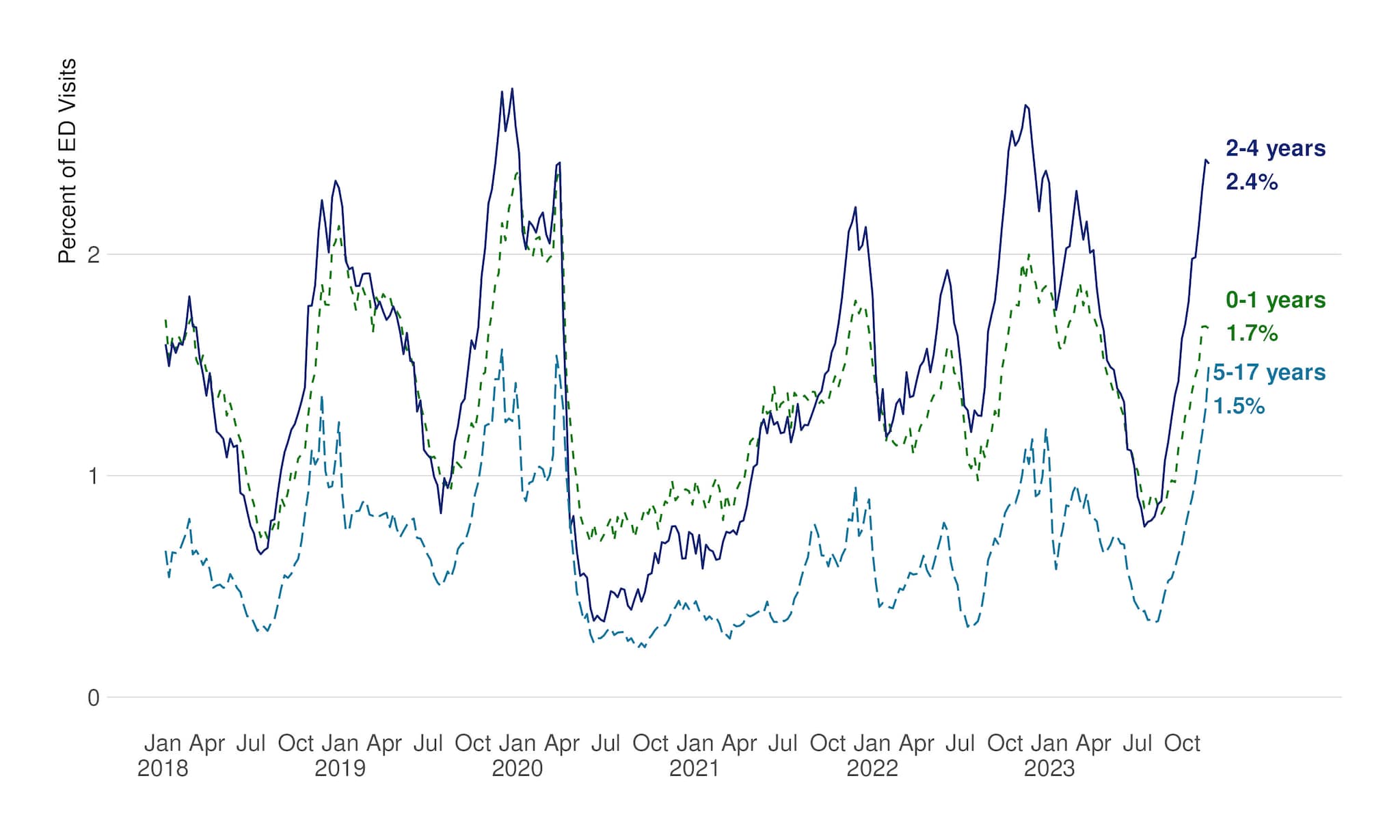December 1, 2023, 8:30 PM EDT
CDC is posting updates on respiratory viruses every week; for the latest information, please visit CDC Respiratory Virus Updates.
Key Information
- CDC is monitoring reports of increased respiratory illness around the world.
- Diagnosis of pneumonia in children, along with other respiratory illnesses, increases every year in the fall and winter months.
- In the United States, CDC monitors increases in respiratory illness, including pneumonia, through multiple data sources.
- The weekly percent of emergency department visits with diagnosed pneumonia is largely consistent with previous years for children aged 0 to 4 years, with slight increases above typical levels for children aged 5 to 17 years, but still consistent with pre-pandemic years.
- These increases are likely caused by viruses and bacteria we expect to see during the respiratory illness season.
- There are many ways to protect yourself from serious illness this fall and winter, including effective immunizations that protect against viral and bacterial diseases that can lead to pneumonia.
Pediatric Pneumonia Update
CDC has been monitoring increases in respiratory illness reported recently around the world, including in China and several European countries. CDC is working closely with international, state, and local public health partners to maintain strong situational awareness. In the United States, CDC uses multiple data sources to monitor for increases in respiratory illness, including pneumonia, which can be caused by many pathogens. One data source is the National Syndromic Surveillance Program (NSSP), which monitors anonymized daily visit data from around 78% of emergency departments in the United States.
The diagnosis of pneumonia in children, along with other respiratory illnesses, increases every year during the fall and winter months in the United States. As of November 25, 2023, NSSP data indicated that the weekly percent of emergency department visits with diagnosed pneumonia was
- 1.7% for children aged 0–1 years,
- 2.4% for children aged 2–4 years, and
- 1.5% for children aged 5–17 years.
These rates are roughly in line with previous years for patients aged 0–1 years and 2–4 years nationally (Figure 1).
National Weekly Percent of Emergency Department Visits for Pneumonia Among Patients Aged 0-17 Years

Data through 11/25/2023; data as of 12/1/2023
The percent of emergency department visits diagnosed with pneumonia among patients aged 5–17 years is similar to pre-pandemic years, and it remains lower than that seen among younger children. CDC will continue to work with state and local health departments to monitor these rates closely.
Based on laboratory findings, these increases in pediatric pneumonia do not appear to be caused by a new virus or other pathogen. Instead, these increases are likely caused by viruses and bacteria we expect to see during the respiratory illness season. CDC will continue to work with state and local officials to monitor the situation. Additional information about the current state of viral respiratory illness can be found at: Weekly Viral Respiratory Illness Snapshot (cdc.gov).
As we progress into respiratory season, we can do more than ever to help prevent people from becoming severely ill from respiratory illness. This includes:
- Safe and effective immunizations – For the first time ever, immunizations are available for three major fall and winter viral respiratory diseases – flu, COVID-19, and respiratory syncytial virus (RSV) — which can cause pneumonia. Pneumococcal vaccines are also available to prevent the most common type of bacterial pneumonia. Pertussis (whooping cough) vaccines are available to prevent another common bacterial respiratory infection that can lead to pneumonia.
- Widely available, effective treatments – Antiviral treatments are available for flu and COVID-19, and antibiotics are used to treat respiratory diseases caused by bacteria such as Mycoplasma pneumoniae infection, pneumococcal disease, and whooping cough. These treatments can reduce risk of severe illness, hospitalization, and death.
- Testing – Tests, some of which can be used at home, can quickly detect COVID-19 and flu. There are also tests for illnesses caused by bacteria, but a healthcare provider needs to perform these tests. Getting tested quickly is important, so there is no delay in treatment and other actions that can protect family, friends, and coworkers.
- Other ways to protect yourself – Other actions like masking, physical distancing, washing hands, and improving ventilation in the places where people live and work can provide additional layers of protection.
Original Article – https://www.cdc.gov/respiratory-viruses/whats-new/pediatric-pneumonia-update.html





